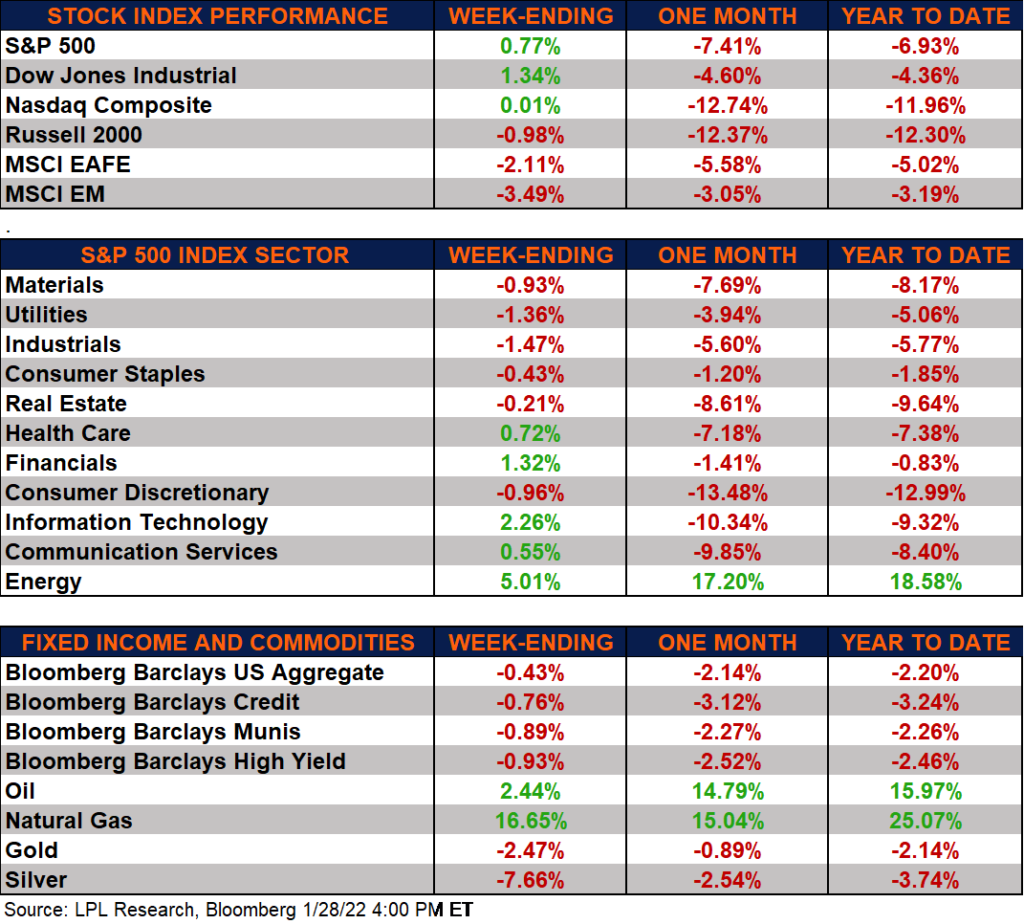
U.S. Markets Rebound After Three Weeks of Lower Closes

U.S. and International Equities
U.S. Markets Higher
The major equity markets finished the week higher even as inflation, higher interest rates, and tighter Federal Reserve (Fed) policy remained on investors’ minds. Investors scooped up beaten-down names at the end of the day Friday to lift the averages. While S&P 500 Index companies have mostly delivered better-than-expected results during earnings season, relatively high equity valuations for high-growth companies have added increased volatility to the markets. The energy sector continues to be a bright spot in 2022, riding the back of higher oil and gas prices.
International markets finished lower this week and fell behind their U.S. counterparts. Emerging markets, which were last year’s laggards on the back of concerns over Chinese regulation and real estate indebtedness, lagged all major markets for the week.
Fixed Income Lower
The Bloomberg Aggregate Bond Index finished lower for the second straight week. High-quality bonds continue to be challenged as traders sold off longer-term government bonds and priced in a more aggressive timetable for Fed rate hikes. This sentiment carried over to high-yield corporate bonds, as tracked by the Bloomberg High Yield index, as these bonds have lost ground for two straight weeks.
Mixed Week for Commodities
After giving back over 7% last week, natural gas surged over 17% this week. In addition, oil continues its steady march higher as we progress through the New Year. The major metals, gold, silver, and copper, after finishing higher for past two weeks, all finished lower this week with silver down over 8%.
Economic Weekly Roundup
Fed talk
The Federal Reserve (Fed) ended its two-day Federal Open Market Committee (FOMC) meeting Wednesday. The outcome was consistent with the Fed’s recent hawkish shift. Chairman Powell confirmed that the FOMC is “of mind to raise rates at the March meeting” and the Committee believes there is ample room to increase rates “without threatening the labor market”. While most of the details were consistent with market expectations, there were some details that implied that the Fed may move faster than expected.
Some Positive Inflation News
The Bureau of Labor Statistics reported that the Employment Cost Index (ECI) rose just 1% in the fourth quarter. This came in below economists’ forecasts as well as declined from 1.3% in the third quarter. The core personal consumption expenditure (PCE) price index, which excludes food and energy prices, rose 4.9% year over year in December, near the prior month (4.7%) and roughly in line with the economists’ consensus forecast of 4.8%.
U.S. GDP Surpasses Estimates
The economy grew almost 7% annualized during the fourth quarter, which came in above economists’ consensus forecasts of 5.5%. Inventories contributed a massive 4.9 percentage points to growth, suggesting the headline number overstates the strength in the U.S. economy. First quarter GDP will likely be slightly weaker than previously anticipated given the strong inventory build that, most likely, will not repeat for this quarter.
Jobless Claims Decline amid a Bevy of Omicron Cases
Initial claims for unemployment insurance declined for the week ending January 22, reaching 260 thousand, meeting economists’ expectations. The fall in claims is likely attributed to recalibrated seasonal hiring in the workforce and disruptions from the COVID-19 Omicron variant. Continuing claims rose to over 1.67M, which was over economists’ expectations. Our view is that we expect claims to decline over the next several weeks.
The following economic data is slated to be released during the week ahead:
- Tuesday: Final January Markit Purchasing Managers’ Index, Institute for Supply Management Manufacturing Report, December construction spending, Job Opening and Labor Turnover Survey (JOLTS) December job openings
- Wednesday: January ADP employment survey
- Thursday: Weekly initial and continuing unemployment claims, January total vehicle sales, Q4 productivity and unit labor costs, Markit composite output index, December durable and factory orders, Institute for Supply Management January Non-Manufacturing Report
- Friday: January hourly earnings and workweek statistics, manufacturing and non-farm payrolls, January employment report
Next week, over 110 S&P 500 companies will report their fourth quarter 2021 earnings results.
IMPORTANT DISCLOSURES
This material is for general information only and is not intended to provide specific advice or recommendations for any individual. There is no assurance that the views or strategies discussed are suitable for all investors or will yield positive outcomes. Investing involves risks including possible loss of principal. Any economic forecasts set forth may not develop as predicted and are subject to change.
References to markets, asset classes, and sectors are generally regarding the corresponding market index. Indexes are unmanaged statistical composites and cannot be invested into directly. Index performance is not indicative of the performance of any investment and do not reflect fees, expenses, or sales charges. All performance referenced is historical and is no guarantee of future results. All market and index data comes from FactSet and MarketWatch.
Any company names noted herein are for educational purposes only and not an indication of trading intent or a solicitation of their products or services. LPL Financial doesn’t provide research on individual equities. All information is believed to be from reliable sources; however, LPL Financial makes no representation as to its completeness or accuracy.
U.S. Treasuries may be considered “safe haven” investments but do carry some degree of risk including interest rate, credit, and market risk. Bonds are subject to market and interest rate risk if sold prior to maturity. Bond values will decline as interest rates rise and bonds are subject to availability and change in price.
For a list of descriptions of the indexes referenced in this publication, please visit our website at lplresearch.com/definitions.
This Research material was prepared by LPL Financial LLC.
Securities and advisory services offered through LPL Financial (LPL), a registered investment advisor and broker-dealer (member FINRA/SIPC).
Insurance products are offered through LPL or its licensed affiliates. To the extent you are receiving investment advice from a separately registered independent investment advisor that is not an LPL affiliate, please note LPL makes no representation with respect to such entity.
- Not Insured by FDIC/NCUA or Any Other Government Agency
- Not Bank/Credit Union Guaranteed
- Not Bank/Credit Union Deposits or Obligations
- May Lose Value
For Public Use – Tracking #1-05238542